Business Law Case Study: Analysis of Hadley v. Baxendale Judgement
VerifiedAdded on 2022/09/08
|19
|10165
|30
Case Study
AI Summary
This case analysis focuses on the landmark case of Hadley v. Baxendale, a cornerstone of business law concerning breach of contract and consequential damages. The case involves millers (Hadley et al.) whose broken crankshaft was delayed in delivery by carriers (Baxendale and Ors), leading to lost profits. The court established the principle that damages for breach of contract should be those arising naturally from the breach or reasonably contemplated by both parties at the time of contract formation. The ruling emphasizes the importance of communicated special circumstances; if these circumstances are not known, the breaching party is only liable for damages that would generally arise. The analysis examines the facts, arguments, and the court's decision, highlighting the importance of foreseeability and communication in determining liability for damages, ultimately shaping modern contract law principles.
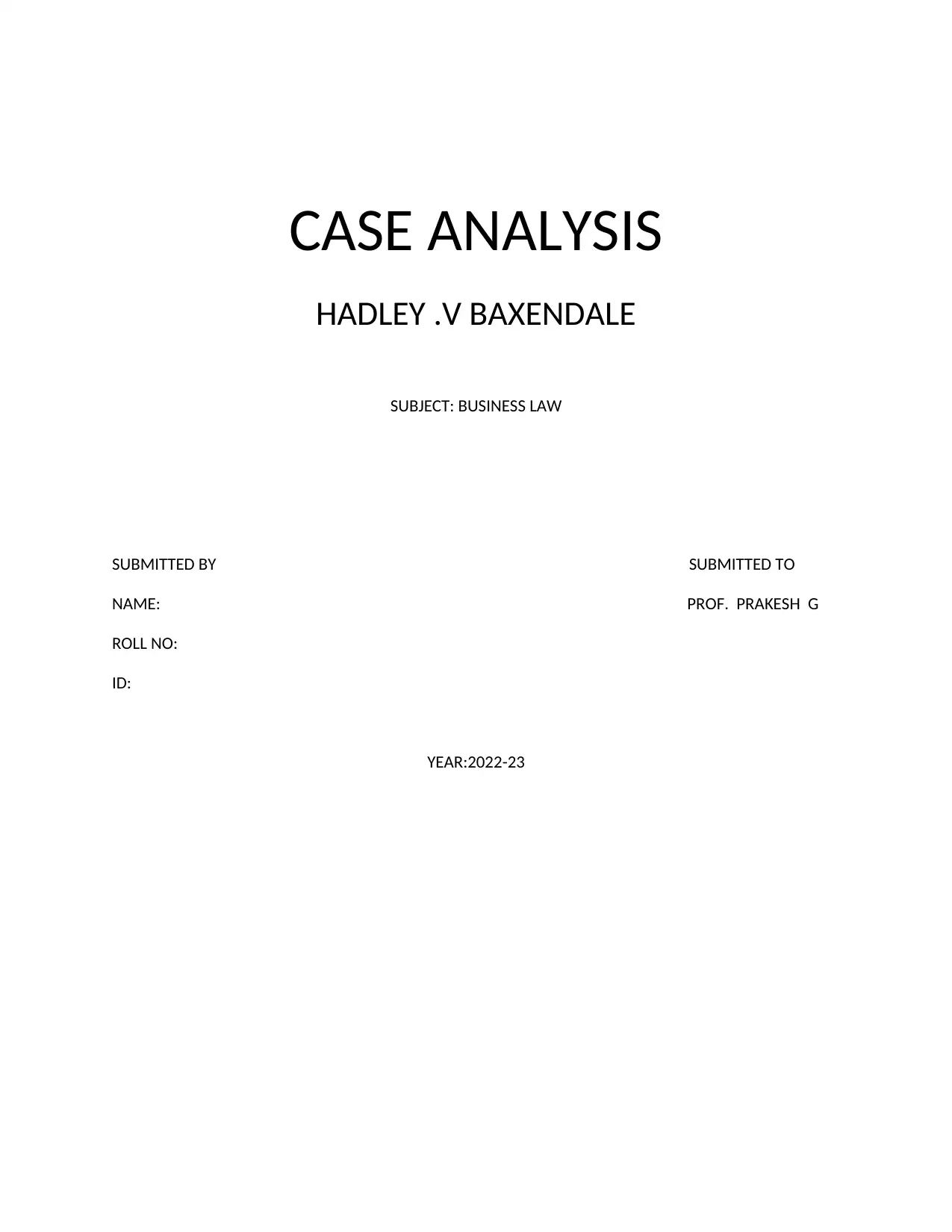
CASE ANALYSIS
HADLEY .V BAXENDALE
SUBJECT: BUSINESS LAW
SUBMITTED BY SUBMITTED TO
NAME: PROF. PRAKESH G
ROLL NO:
ID:
YEAR:2022-23
HADLEY .V BAXENDALE
SUBJECT: BUSINESS LAW
SUBMITTED BY SUBMITTED TO
NAME: PROF. PRAKESH G
ROLL NO:
ID:
YEAR:2022-23
Paraphrase This Document
Need a fresh take? Get an instant paraphrase of this document with our AI Paraphraser
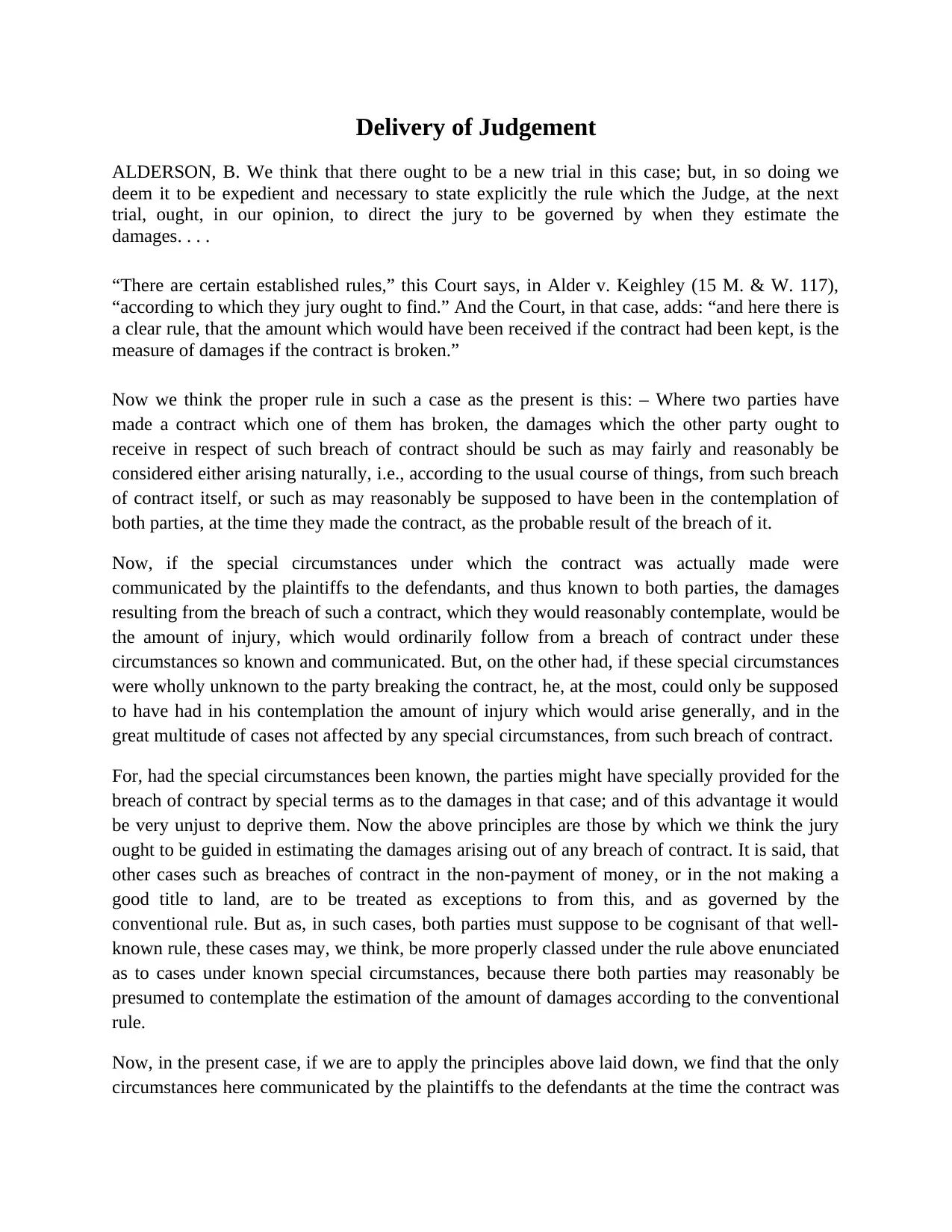
Delivery of Judgement
ALDERSON, B. We think that there ought to be a new trial in this case; but, in so doing we
deem it to be expedient and necessary to state explicitly the rule which the Judge, at the next
trial, ought, in our opinion, to direct the jury to be governed by when they estimate the
damages. . . .
“There are certain established rules,” this Court says, in Alder v. Keighley (15 M. & W. 117),
“according to which they jury ought to find.” And the Court, in that case, adds: “and here there is
a clear rule, that the amount which would have been received if the contract had been kept, is the
measure of damages if the contract is broken.”
Now we think the proper rule in such a case as the present is this: – Where two parties have
made a contract which one of them has broken, the damages which the other party ought to
receive in respect of such breach of contract should be such as may fairly and reasonably be
considered either arising naturally, i.e., according to the usual course of things, from such breach
of contract itself, or such as may reasonably be supposed to have been in the contemplation of
both parties, at the time they made the contract, as the probable result of the breach of it.
Now, if the special circumstances under which the contract was actually made were
communicated by the plaintiffs to the defendants, and thus known to both parties, the damages
resulting from the breach of such a contract, which they would reasonably contemplate, would be
the amount of injury, which would ordinarily follow from a breach of contract under these
circumstances so known and communicated. But, on the other had, if these special circumstances
were wholly unknown to the party breaking the contract, he, at the most, could only be supposed
to have had in his contemplation the amount of injury which would arise generally, and in the
great multitude of cases not affected by any special circumstances, from such breach of contract.
For, had the special circumstances been known, the parties might have specially provided for the
breach of contract by special terms as to the damages in that case; and of this advantage it would
be very unjust to deprive them. Now the above principles are those by which we think the jury
ought to be guided in estimating the damages arising out of any breach of contract. It is said, that
other cases such as breaches of contract in the non-payment of money, or in the not making a
good title to land, are to be treated as exceptions to from this, and as governed by the
conventional rule. But as, in such cases, both parties must suppose to be cognisant of that well-
known rule, these cases may, we think, be more properly classed under the rule above enunciated
as to cases under known special circumstances, because there both parties may reasonably be
presumed to contemplate the estimation of the amount of damages according to the conventional
rule.
Now, in the present case, if we are to apply the principles above laid down, we find that the only
circumstances here communicated by the plaintiffs to the defendants at the time the contract was
ALDERSON, B. We think that there ought to be a new trial in this case; but, in so doing we
deem it to be expedient and necessary to state explicitly the rule which the Judge, at the next
trial, ought, in our opinion, to direct the jury to be governed by when they estimate the
damages. . . .
“There are certain established rules,” this Court says, in Alder v. Keighley (15 M. & W. 117),
“according to which they jury ought to find.” And the Court, in that case, adds: “and here there is
a clear rule, that the amount which would have been received if the contract had been kept, is the
measure of damages if the contract is broken.”
Now we think the proper rule in such a case as the present is this: – Where two parties have
made a contract which one of them has broken, the damages which the other party ought to
receive in respect of such breach of contract should be such as may fairly and reasonably be
considered either arising naturally, i.e., according to the usual course of things, from such breach
of contract itself, or such as may reasonably be supposed to have been in the contemplation of
both parties, at the time they made the contract, as the probable result of the breach of it.
Now, if the special circumstances under which the contract was actually made were
communicated by the plaintiffs to the defendants, and thus known to both parties, the damages
resulting from the breach of such a contract, which they would reasonably contemplate, would be
the amount of injury, which would ordinarily follow from a breach of contract under these
circumstances so known and communicated. But, on the other had, if these special circumstances
were wholly unknown to the party breaking the contract, he, at the most, could only be supposed
to have had in his contemplation the amount of injury which would arise generally, and in the
great multitude of cases not affected by any special circumstances, from such breach of contract.
For, had the special circumstances been known, the parties might have specially provided for the
breach of contract by special terms as to the damages in that case; and of this advantage it would
be very unjust to deprive them. Now the above principles are those by which we think the jury
ought to be guided in estimating the damages arising out of any breach of contract. It is said, that
other cases such as breaches of contract in the non-payment of money, or in the not making a
good title to land, are to be treated as exceptions to from this, and as governed by the
conventional rule. But as, in such cases, both parties must suppose to be cognisant of that well-
known rule, these cases may, we think, be more properly classed under the rule above enunciated
as to cases under known special circumstances, because there both parties may reasonably be
presumed to contemplate the estimation of the amount of damages according to the conventional
rule.
Now, in the present case, if we are to apply the principles above laid down, we find that the only
circumstances here communicated by the plaintiffs to the defendants at the time the contract was
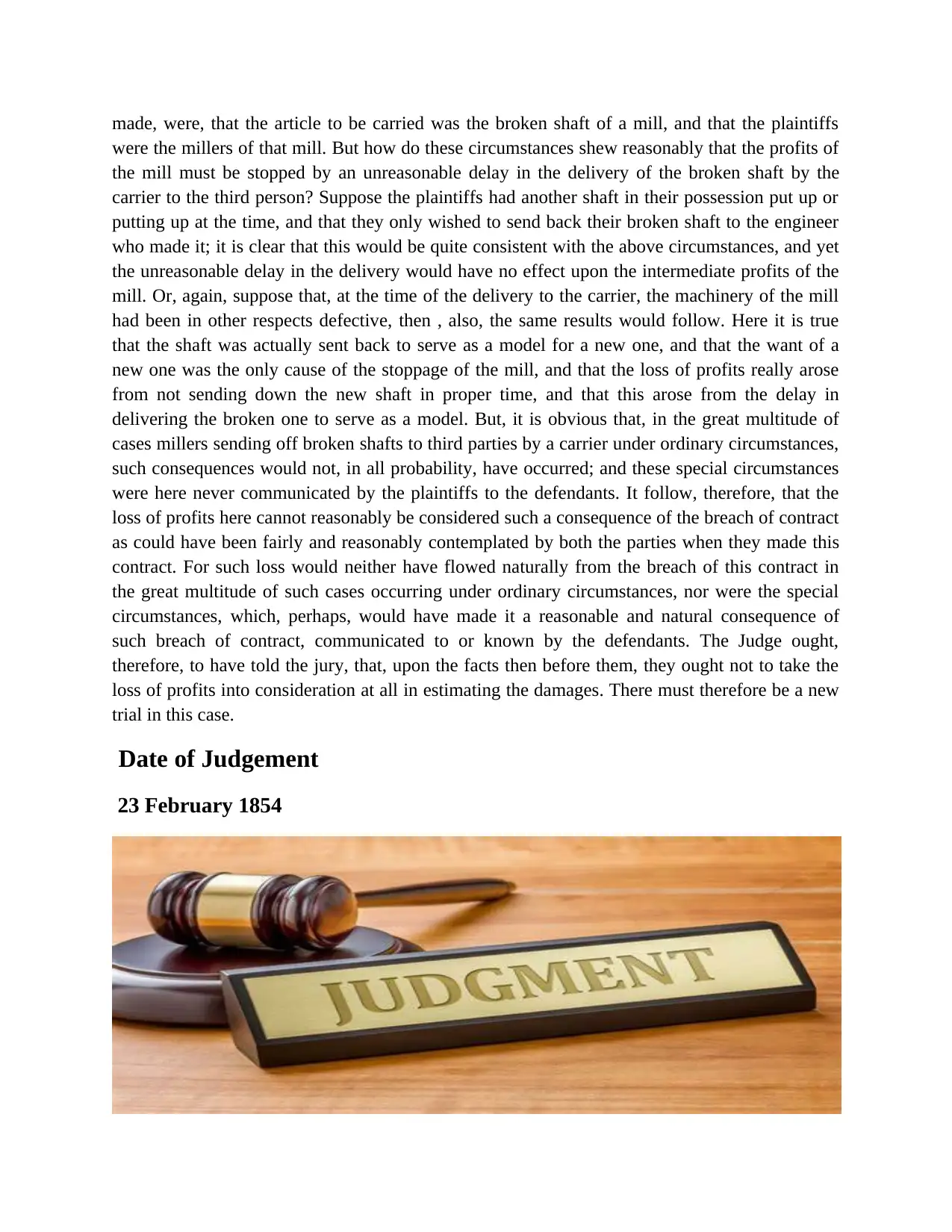
made, were, that the article to be carried was the broken shaft of a mill, and that the plaintiffs
were the millers of that mill. But how do these circumstances shew reasonably that the profits of
the mill must be stopped by an unreasonable delay in the delivery of the broken shaft by the
carrier to the third person? Suppose the plaintiffs had another shaft in their possession put up or
putting up at the time, and that they only wished to send back their broken shaft to the engineer
who made it; it is clear that this would be quite consistent with the above circumstances, and yet
the unreasonable delay in the delivery would have no effect upon the intermediate profits of the
mill. Or, again, suppose that, at the time of the delivery to the carrier, the machinery of the mill
had been in other respects defective, then , also, the same results would follow. Here it is true
that the shaft was actually sent back to serve as a model for a new one, and that the want of a
new one was the only cause of the stoppage of the mill, and that the loss of profits really arose
from not sending down the new shaft in proper time, and that this arose from the delay in
delivering the broken one to serve as a model. But, it is obvious that, in the great multitude of
cases millers sending off broken shafts to third parties by a carrier under ordinary circumstances,
such consequences would not, in all probability, have occurred; and these special circumstances
were here never communicated by the plaintiffs to the defendants. It follow, therefore, that the
loss of profits here cannot reasonably be considered such a consequence of the breach of contract
as could have been fairly and reasonably contemplated by both the parties when they made this
contract. For such loss would neither have flowed naturally from the breach of this contract in
the great multitude of such cases occurring under ordinary circumstances, nor were the special
circumstances, which, perhaps, would have made it a reasonable and natural consequence of
such breach of contract, communicated to or known by the defendants. The Judge ought,
therefore, to have told the jury, that, upon the facts then before them, they ought not to take the
loss of profits into consideration at all in estimating the damages. There must therefore be a new
trial in this case.
Date of Judgement
23 February 1854
were the millers of that mill. But how do these circumstances shew reasonably that the profits of
the mill must be stopped by an unreasonable delay in the delivery of the broken shaft by the
carrier to the third person? Suppose the plaintiffs had another shaft in their possession put up or
putting up at the time, and that they only wished to send back their broken shaft to the engineer
who made it; it is clear that this would be quite consistent with the above circumstances, and yet
the unreasonable delay in the delivery would have no effect upon the intermediate profits of the
mill. Or, again, suppose that, at the time of the delivery to the carrier, the machinery of the mill
had been in other respects defective, then , also, the same results would follow. Here it is true
that the shaft was actually sent back to serve as a model for a new one, and that the want of a
new one was the only cause of the stoppage of the mill, and that the loss of profits really arose
from not sending down the new shaft in proper time, and that this arose from the delay in
delivering the broken one to serve as a model. But, it is obvious that, in the great multitude of
cases millers sending off broken shafts to third parties by a carrier under ordinary circumstances,
such consequences would not, in all probability, have occurred; and these special circumstances
were here never communicated by the plaintiffs to the defendants. It follow, therefore, that the
loss of profits here cannot reasonably be considered such a consequence of the breach of contract
as could have been fairly and reasonably contemplated by both the parties when they made this
contract. For such loss would neither have flowed naturally from the breach of this contract in
the great multitude of such cases occurring under ordinary circumstances, nor were the special
circumstances, which, perhaps, would have made it a reasonable and natural consequence of
such breach of contract, communicated to or known by the defendants. The Judge ought,
therefore, to have told the jury, that, upon the facts then before them, they ought not to take the
loss of profits into consideration at all in estimating the damages. There must therefore be a new
trial in this case.
Date of Judgement
23 February 1854
⊘ This is a preview!⊘
Do you want full access?
Subscribe today to unlock all pages.

Trusted by 1+ million students worldwide
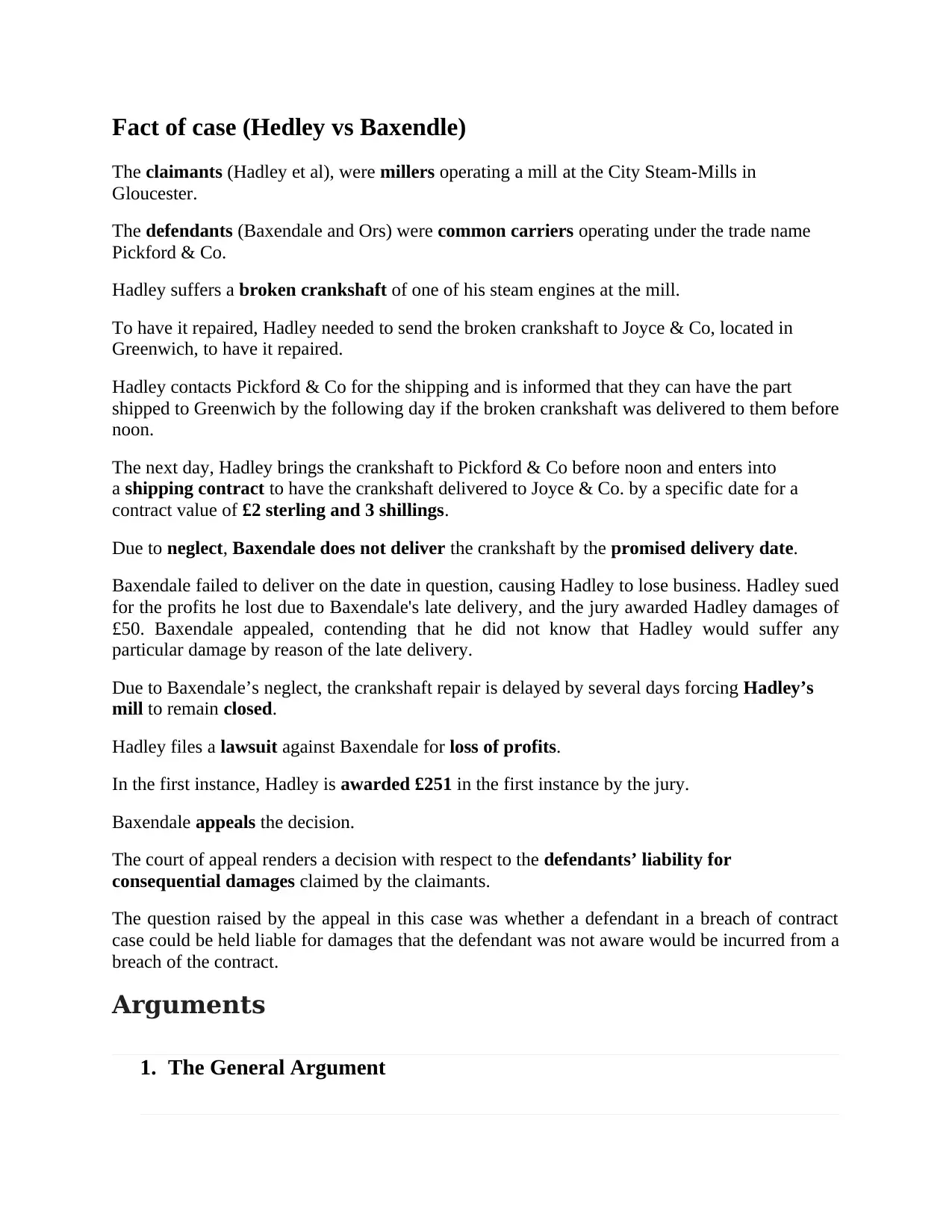
Fact of case (Hedley vs Baxendle)
The claimants (Hadley et al), were millers operating a mill at the City Steam-Mills in
Gloucester.
The defendants (Baxendale and Ors) were common carriers operating under the trade name
Pickford & Co.
Hadley suffers a broken crankshaft of one of his steam engines at the mill.
To have it repaired, Hadley needed to send the broken crankshaft to Joyce & Co, located in
Greenwich, to have it repaired.
Hadley contacts Pickford & Co for the shipping and is informed that they can have the part
shipped to Greenwich by the following day if the broken crankshaft was delivered to them before
noon.
The next day, Hadley brings the crankshaft to Pickford & Co before noon and enters into
a shipping contract to have the crankshaft delivered to Joyce & Co. by a specific date for a
contract value of £2 sterling and 3 shillings.
Due to neglect, Baxendale does not deliver the crankshaft by the promised delivery date.
Baxendale failed to deliver on the date in question, causing Hadley to lose business. Hadley sued
for the profits he lost due to Baxendale's late delivery, and the jury awarded Hadley damages of
£50. Baxendale appealed, contending that he did not know that Hadley would suffer any
particular damage by reason of the late delivery.
Due to Baxendale’s neglect, the crankshaft repair is delayed by several days forcing Hadley’s
mill to remain closed.
Hadley files a lawsuit against Baxendale for loss of profits.
In the first instance, Hadley is awarded £251 in the first instance by the jury.
Baxendale appeals the decision.
The court of appeal renders a decision with respect to the defendants’ liability for
consequential damages claimed by the claimants.
The question raised by the appeal in this case was whether a defendant in a breach of contract
case could be held liable for damages that the defendant was not aware would be incurred from a
breach of the contract.
Arguments
1. The General Argument
The claimants (Hadley et al), were millers operating a mill at the City Steam-Mills in
Gloucester.
The defendants (Baxendale and Ors) were common carriers operating under the trade name
Pickford & Co.
Hadley suffers a broken crankshaft of one of his steam engines at the mill.
To have it repaired, Hadley needed to send the broken crankshaft to Joyce & Co, located in
Greenwich, to have it repaired.
Hadley contacts Pickford & Co for the shipping and is informed that they can have the part
shipped to Greenwich by the following day if the broken crankshaft was delivered to them before
noon.
The next day, Hadley brings the crankshaft to Pickford & Co before noon and enters into
a shipping contract to have the crankshaft delivered to Joyce & Co. by a specific date for a
contract value of £2 sterling and 3 shillings.
Due to neglect, Baxendale does not deliver the crankshaft by the promised delivery date.
Baxendale failed to deliver on the date in question, causing Hadley to lose business. Hadley sued
for the profits he lost due to Baxendale's late delivery, and the jury awarded Hadley damages of
£50. Baxendale appealed, contending that he did not know that Hadley would suffer any
particular damage by reason of the late delivery.
Due to Baxendale’s neglect, the crankshaft repair is delayed by several days forcing Hadley’s
mill to remain closed.
Hadley files a lawsuit against Baxendale for loss of profits.
In the first instance, Hadley is awarded £251 in the first instance by the jury.
Baxendale appeals the decision.
The court of appeal renders a decision with respect to the defendants’ liability for
consequential damages claimed by the claimants.
The question raised by the appeal in this case was whether a defendant in a breach of contract
case could be held liable for damages that the defendant was not aware would be incurred from a
breach of the contract.
Arguments
1. The General Argument
Paraphrase This Document
Need a fresh take? Get an instant paraphrase of this document with our AI Paraphraser
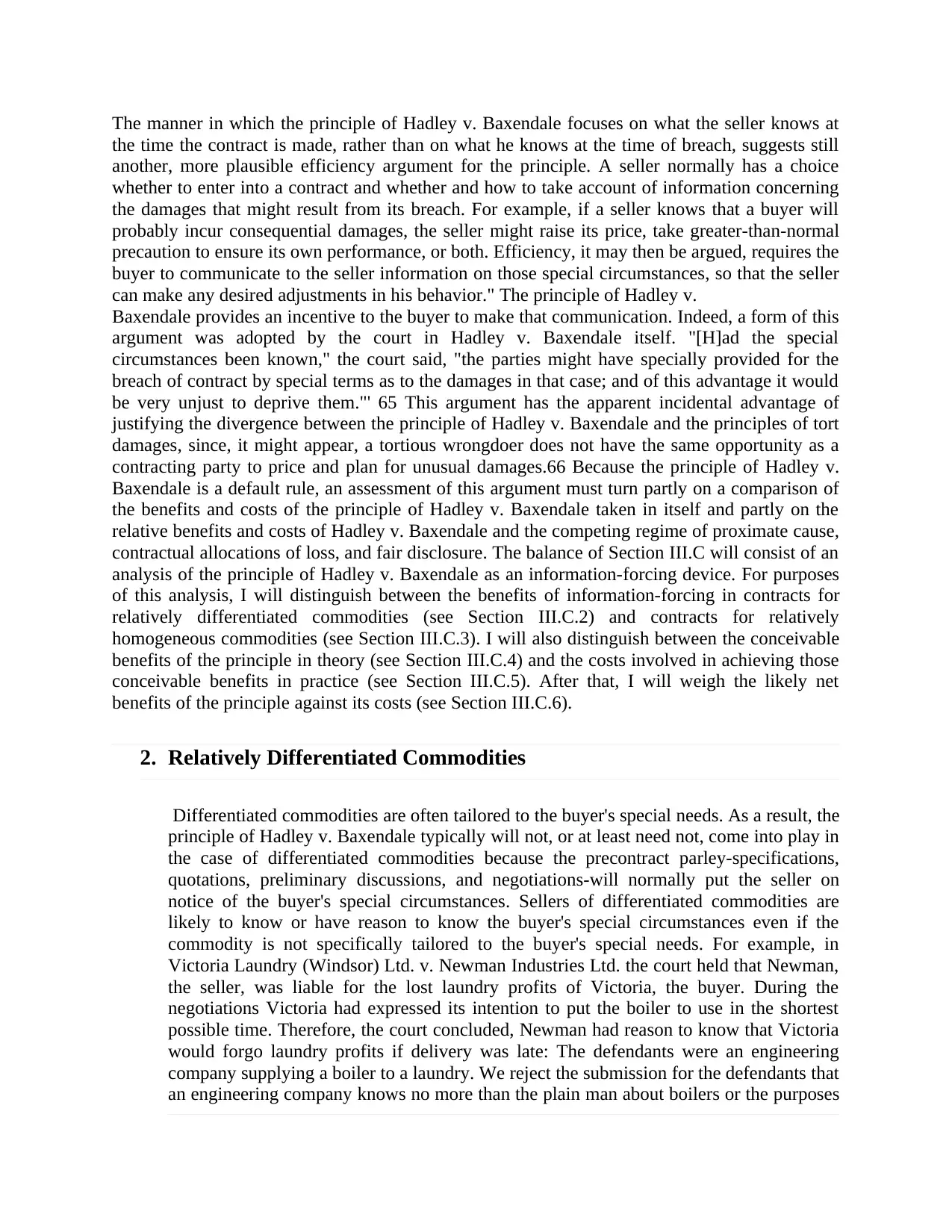
The manner in which the principle of Hadley v. Baxendale focuses on what the seller knows at
the time the contract is made, rather than on what he knows at the time of breach, suggests still
another, more plausible efficiency argument for the principle. A seller normally has a choice
whether to enter into a contract and whether and how to take account of information concerning
the damages that might result from its breach. For example, if a seller knows that a buyer will
probably incur consequential damages, the seller might raise its price, take greater-than-normal
precaution to ensure its own performance, or both. Efficiency, it may then be argued, requires the
buyer to communicate to the seller information on those special circumstances, so that the seller
can make any desired adjustments in his behavior." The principle of Hadley v.
Baxendale provides an incentive to the buyer to make that communication. Indeed, a form of this
argument was adopted by the court in Hadley v. Baxendale itself. "[H]ad the special
circumstances been known," the court said, "the parties might have specially provided for the
breach of contract by special terms as to the damages in that case; and of this advantage it would
be very unjust to deprive them."' 65 This argument has the apparent incidental advantage of
justifying the divergence between the principle of Hadley v. Baxendale and the principles of tort
damages, since, it might appear, a tortious wrongdoer does not have the same opportunity as a
contracting party to price and plan for unusual damages.66 Because the principle of Hadley v.
Baxendale is a default rule, an assessment of this argument must turn partly on a comparison of
the benefits and costs of the principle of Hadley v. Baxendale taken in itself and partly on the
relative benefits and costs of Hadley v. Baxendale and the competing regime of proximate cause,
contractual allocations of loss, and fair disclosure. The balance of Section III.C will consist of an
analysis of the principle of Hadley v. Baxendale as an information-forcing device. For purposes
of this analysis, I will distinguish between the benefits of information-forcing in contracts for
relatively differentiated commodities (see Section III.C.2) and contracts for relatively
homogeneous commodities (see Section III.C.3). I will also distinguish between the conceivable
benefits of the principle in theory (see Section III.C.4) and the costs involved in achieving those
conceivable benefits in practice (see Section III.C.5). After that, I will weigh the likely net
benefits of the principle against its costs (see Section III.C.6).
2. Relatively Differentiated Commodities
Differentiated commodities are often tailored to the buyer's special needs. As a result, the
principle of Hadley v. Baxendale typically will not, or at least need not, come into play in
the case of differentiated commodities because the precontract parley-specifications,
quotations, preliminary discussions, and negotiations-will normally put the seller on
notice of the buyer's special circumstances. Sellers of differentiated commodities are
likely to know or have reason to know the buyer's special circumstances even if the
commodity is not specifically tailored to the buyer's special needs. For example, in
Victoria Laundry (Windsor) Ltd. v. Newman Industries Ltd. the court held that Newman,
the seller, was liable for the lost laundry profits of Victoria, the buyer. During the
negotiations Victoria had expressed its intention to put the boiler to use in the shortest
possible time. Therefore, the court concluded, Newman had reason to know that Victoria
would forgo laundry profits if delivery was late: The defendants were an engineering
company supplying a boiler to a laundry. We reject the submission for the defendants that
an engineering company knows no more than the plain man about boilers or the purposes
the time the contract is made, rather than on what he knows at the time of breach, suggests still
another, more plausible efficiency argument for the principle. A seller normally has a choice
whether to enter into a contract and whether and how to take account of information concerning
the damages that might result from its breach. For example, if a seller knows that a buyer will
probably incur consequential damages, the seller might raise its price, take greater-than-normal
precaution to ensure its own performance, or both. Efficiency, it may then be argued, requires the
buyer to communicate to the seller information on those special circumstances, so that the seller
can make any desired adjustments in his behavior." The principle of Hadley v.
Baxendale provides an incentive to the buyer to make that communication. Indeed, a form of this
argument was adopted by the court in Hadley v. Baxendale itself. "[H]ad the special
circumstances been known," the court said, "the parties might have specially provided for the
breach of contract by special terms as to the damages in that case; and of this advantage it would
be very unjust to deprive them."' 65 This argument has the apparent incidental advantage of
justifying the divergence between the principle of Hadley v. Baxendale and the principles of tort
damages, since, it might appear, a tortious wrongdoer does not have the same opportunity as a
contracting party to price and plan for unusual damages.66 Because the principle of Hadley v.
Baxendale is a default rule, an assessment of this argument must turn partly on a comparison of
the benefits and costs of the principle of Hadley v. Baxendale taken in itself and partly on the
relative benefits and costs of Hadley v. Baxendale and the competing regime of proximate cause,
contractual allocations of loss, and fair disclosure. The balance of Section III.C will consist of an
analysis of the principle of Hadley v. Baxendale as an information-forcing device. For purposes
of this analysis, I will distinguish between the benefits of information-forcing in contracts for
relatively differentiated commodities (see Section III.C.2) and contracts for relatively
homogeneous commodities (see Section III.C.3). I will also distinguish between the conceivable
benefits of the principle in theory (see Section III.C.4) and the costs involved in achieving those
conceivable benefits in practice (see Section III.C.5). After that, I will weigh the likely net
benefits of the principle against its costs (see Section III.C.6).
2. Relatively Differentiated Commodities
Differentiated commodities are often tailored to the buyer's special needs. As a result, the
principle of Hadley v. Baxendale typically will not, or at least need not, come into play in
the case of differentiated commodities because the precontract parley-specifications,
quotations, preliminary discussions, and negotiations-will normally put the seller on
notice of the buyer's special circumstances. Sellers of differentiated commodities are
likely to know or have reason to know the buyer's special circumstances even if the
commodity is not specifically tailored to the buyer's special needs. For example, in
Victoria Laundry (Windsor) Ltd. v. Newman Industries Ltd. the court held that Newman,
the seller, was liable for the lost laundry profits of Victoria, the buyer. During the
negotiations Victoria had expressed its intention to put the boiler to use in the shortest
possible time. Therefore, the court concluded, Newman had reason to know that Victoria
would forgo laundry profits if delivery was late: The defendants were an engineering
company supplying a boiler to a laundry. We reject the submission for the defendants that
an engineering company knows no more than the plain man about boilers or the purposes
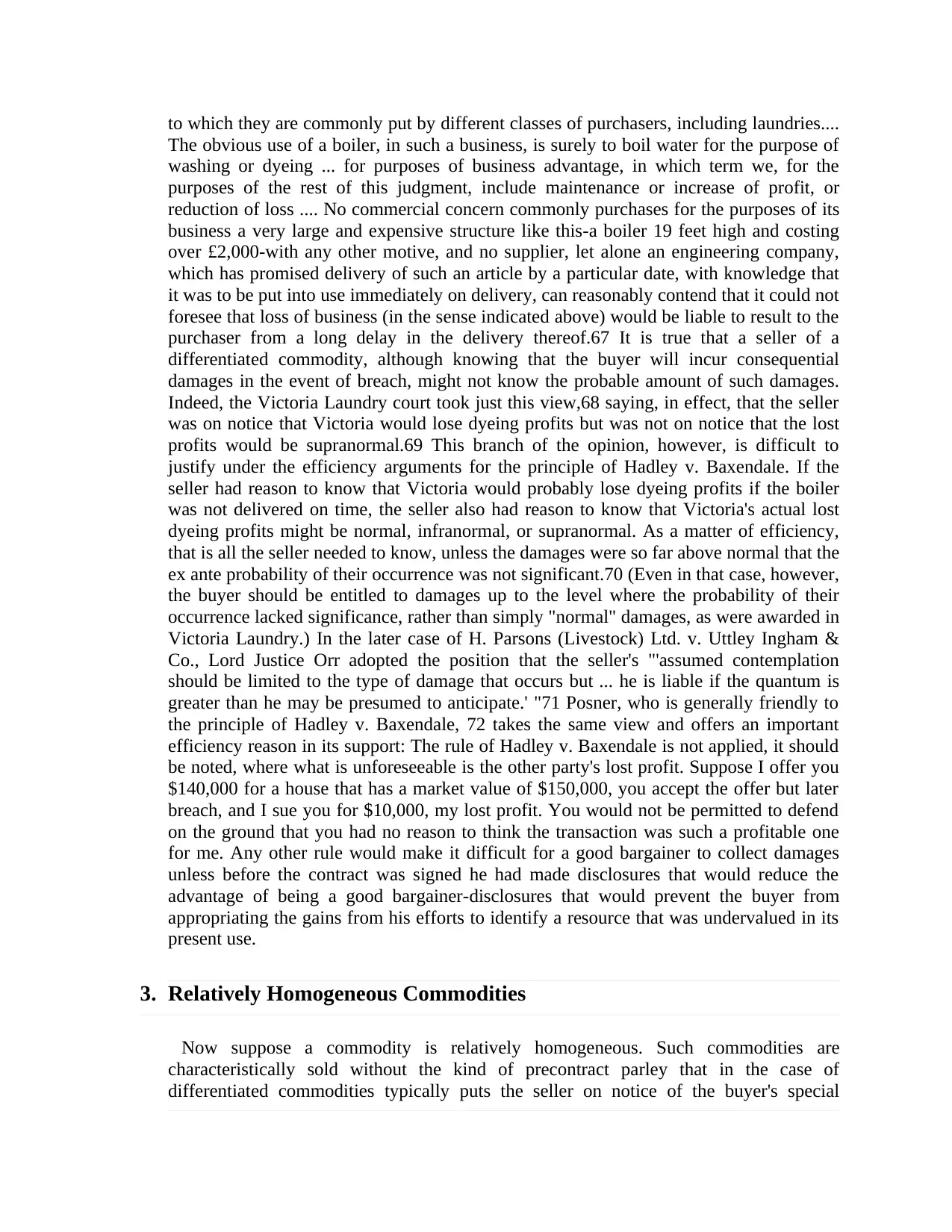
to which they are commonly put by different classes of purchasers, including laundries....
The obvious use of a boiler, in such a business, is surely to boil water for the purpose of
washing or dyeing ... for purposes of business advantage, in which term we, for the
purposes of the rest of this judgment, include maintenance or increase of profit, or
reduction of loss .... No commercial concern commonly purchases for the purposes of its
business a very large and expensive structure like this-a boiler 19 feet high and costing
over £2,000-with any other motive, and no supplier, let alone an engineering company,
which has promised delivery of such an article by a particular date, with knowledge that
it was to be put into use immediately on delivery, can reasonably contend that it could not
foresee that loss of business (in the sense indicated above) would be liable to result to the
purchaser from a long delay in the delivery thereof.67 It is true that a seller of a
differentiated commodity, although knowing that the buyer will incur consequential
damages in the event of breach, might not know the probable amount of such damages.
Indeed, the Victoria Laundry court took just this view,68 saying, in effect, that the seller
was on notice that Victoria would lose dyeing profits but was not on notice that the lost
profits would be supranormal.69 This branch of the opinion, however, is difficult to
justify under the efficiency arguments for the principle of Hadley v. Baxendale. If the
seller had reason to know that Victoria would probably lose dyeing profits if the boiler
was not delivered on time, the seller also had reason to know that Victoria's actual lost
dyeing profits might be normal, infranormal, or supranormal. As a matter of efficiency,
that is all the seller needed to know, unless the damages were so far above normal that the
ex ante probability of their occurrence was not significant.70 (Even in that case, however,
the buyer should be entitled to damages up to the level where the probability of their
occurrence lacked significance, rather than simply "normal" damages, as were awarded in
Victoria Laundry.) In the later case of H. Parsons (Livestock) Ltd. v. Uttley Ingham &
Co., Lord Justice Orr adopted the position that the seller's "'assumed contemplation
should be limited to the type of damage that occurs but ... he is liable if the quantum is
greater than he may be presumed to anticipate.' "71 Posner, who is generally friendly to
the principle of Hadley v. Baxendale, 72 takes the same view and offers an important
efficiency reason in its support: The rule of Hadley v. Baxendale is not applied, it should
be noted, where what is unforeseeable is the other party's lost profit. Suppose I offer you
$140,000 for a house that has a market value of $150,000, you accept the offer but later
breach, and I sue you for $10,000, my lost profit. You would not be permitted to defend
on the ground that you had no reason to think the transaction was such a profitable one
for me. Any other rule would make it difficult for a good bargainer to collect damages
unless before the contract was signed he had made disclosures that would reduce the
advantage of being a good bargainer-disclosures that would prevent the buyer from
appropriating the gains from his efforts to identify a resource that was undervalued in its
present use.
3. Relatively Homogeneous Commodities
Now suppose a commodity is relatively homogeneous. Such commodities are
characteristically sold without the kind of precontract parley that in the case of
differentiated commodities typically puts the seller on notice of the buyer's special
The obvious use of a boiler, in such a business, is surely to boil water for the purpose of
washing or dyeing ... for purposes of business advantage, in which term we, for the
purposes of the rest of this judgment, include maintenance or increase of profit, or
reduction of loss .... No commercial concern commonly purchases for the purposes of its
business a very large and expensive structure like this-a boiler 19 feet high and costing
over £2,000-with any other motive, and no supplier, let alone an engineering company,
which has promised delivery of such an article by a particular date, with knowledge that
it was to be put into use immediately on delivery, can reasonably contend that it could not
foresee that loss of business (in the sense indicated above) would be liable to result to the
purchaser from a long delay in the delivery thereof.67 It is true that a seller of a
differentiated commodity, although knowing that the buyer will incur consequential
damages in the event of breach, might not know the probable amount of such damages.
Indeed, the Victoria Laundry court took just this view,68 saying, in effect, that the seller
was on notice that Victoria would lose dyeing profits but was not on notice that the lost
profits would be supranormal.69 This branch of the opinion, however, is difficult to
justify under the efficiency arguments for the principle of Hadley v. Baxendale. If the
seller had reason to know that Victoria would probably lose dyeing profits if the boiler
was not delivered on time, the seller also had reason to know that Victoria's actual lost
dyeing profits might be normal, infranormal, or supranormal. As a matter of efficiency,
that is all the seller needed to know, unless the damages were so far above normal that the
ex ante probability of their occurrence was not significant.70 (Even in that case, however,
the buyer should be entitled to damages up to the level where the probability of their
occurrence lacked significance, rather than simply "normal" damages, as were awarded in
Victoria Laundry.) In the later case of H. Parsons (Livestock) Ltd. v. Uttley Ingham &
Co., Lord Justice Orr adopted the position that the seller's "'assumed contemplation
should be limited to the type of damage that occurs but ... he is liable if the quantum is
greater than he may be presumed to anticipate.' "71 Posner, who is generally friendly to
the principle of Hadley v. Baxendale, 72 takes the same view and offers an important
efficiency reason in its support: The rule of Hadley v. Baxendale is not applied, it should
be noted, where what is unforeseeable is the other party's lost profit. Suppose I offer you
$140,000 for a house that has a market value of $150,000, you accept the offer but later
breach, and I sue you for $10,000, my lost profit. You would not be permitted to defend
on the ground that you had no reason to think the transaction was such a profitable one
for me. Any other rule would make it difficult for a good bargainer to collect damages
unless before the contract was signed he had made disclosures that would reduce the
advantage of being a good bargainer-disclosures that would prevent the buyer from
appropriating the gains from his efforts to identify a resource that was undervalued in its
present use.
3. Relatively Homogeneous Commodities
Now suppose a commodity is relatively homogeneous. Such commodities are
characteristically sold without the kind of precontract parley that in the case of
differentiated commodities typically puts the seller on notice of the buyer's special
⊘ This is a preview!⊘
Do you want full access?
Subscribe today to unlock all pages.

Trusted by 1+ million students worldwide
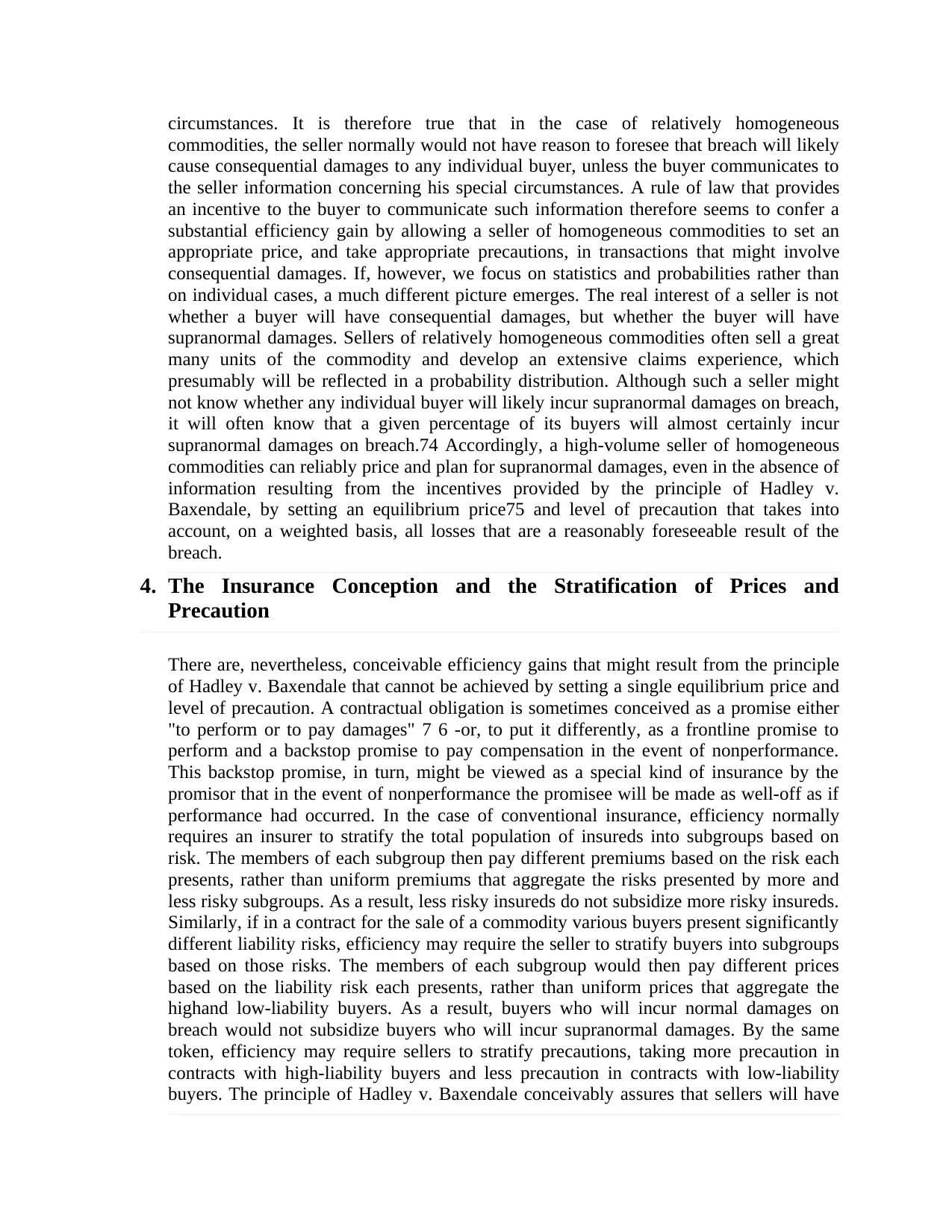
circumstances. It is therefore true that in the case of relatively homogeneous
commodities, the seller normally would not have reason to foresee that breach will likely
cause consequential damages to any individual buyer, unless the buyer communicates to
the seller information concerning his special circumstances. A rule of law that provides
an incentive to the buyer to communicate such information therefore seems to confer a
substantial efficiency gain by allowing a seller of homogeneous commodities to set an
appropriate price, and take appropriate precautions, in transactions that might involve
consequential damages. If, however, we focus on statistics and probabilities rather than
on individual cases, a much different picture emerges. The real interest of a seller is not
whether a buyer will have consequential damages, but whether the buyer will have
supranormal damages. Sellers of relatively homogeneous commodities often sell a great
many units of the commodity and develop an extensive claims experience, which
presumably will be reflected in a probability distribution. Although such a seller might
not know whether any individual buyer will likely incur supranormal damages on breach,
it will often know that a given percentage of its buyers will almost certainly incur
supranormal damages on breach.74 Accordingly, a high-volume seller of homogeneous
commodities can reliably price and plan for supranormal damages, even in the absence of
information resulting from the incentives provided by the principle of Hadley v.
Baxendale, by setting an equilibrium price75 and level of precaution that takes into
account, on a weighted basis, all losses that are a reasonably foreseeable result of the
breach.
4. The Insurance Conception and the Stratification of Prices and
Precaution
There are, nevertheless, conceivable efficiency gains that might result from the principle
of Hadley v. Baxendale that cannot be achieved by setting a single equilibrium price and
level of precaution. A contractual obligation is sometimes conceived as a promise either
"to perform or to pay damages" 7 6 -or, to put it differently, as a frontline promise to
perform and a backstop promise to pay compensation in the event of nonperformance.
This backstop promise, in turn, might be viewed as a special kind of insurance by the
promisor that in the event of nonperformance the promisee will be made as well-off as if
performance had occurred. In the case of conventional insurance, efficiency normally
requires an insurer to stratify the total population of insureds into subgroups based on
risk. The members of each subgroup then pay different premiums based on the risk each
presents, rather than uniform premiums that aggregate the risks presented by more and
less risky subgroups. As a result, less risky insureds do not subsidize more risky insureds.
Similarly, if in a contract for the sale of a commodity various buyers present significantly
different liability risks, efficiency may require the seller to stratify buyers into subgroups
based on those risks. The members of each subgroup would then pay different prices
based on the liability risk each presents, rather than uniform prices that aggregate the
highand low-liability buyers. As a result, buyers who will incur normal damages on
breach would not subsidize buyers who will incur supranormal damages. By the same
token, efficiency may require sellers to stratify precautions, taking more precaution in
contracts with high-liability buyers and less precaution in contracts with low-liability
buyers. The principle of Hadley v. Baxendale conceivably assures that sellers will have
commodities, the seller normally would not have reason to foresee that breach will likely
cause consequential damages to any individual buyer, unless the buyer communicates to
the seller information concerning his special circumstances. A rule of law that provides
an incentive to the buyer to communicate such information therefore seems to confer a
substantial efficiency gain by allowing a seller of homogeneous commodities to set an
appropriate price, and take appropriate precautions, in transactions that might involve
consequential damages. If, however, we focus on statistics and probabilities rather than
on individual cases, a much different picture emerges. The real interest of a seller is not
whether a buyer will have consequential damages, but whether the buyer will have
supranormal damages. Sellers of relatively homogeneous commodities often sell a great
many units of the commodity and develop an extensive claims experience, which
presumably will be reflected in a probability distribution. Although such a seller might
not know whether any individual buyer will likely incur supranormal damages on breach,
it will often know that a given percentage of its buyers will almost certainly incur
supranormal damages on breach.74 Accordingly, a high-volume seller of homogeneous
commodities can reliably price and plan for supranormal damages, even in the absence of
information resulting from the incentives provided by the principle of Hadley v.
Baxendale, by setting an equilibrium price75 and level of precaution that takes into
account, on a weighted basis, all losses that are a reasonably foreseeable result of the
breach.
4. The Insurance Conception and the Stratification of Prices and
Precaution
There are, nevertheless, conceivable efficiency gains that might result from the principle
of Hadley v. Baxendale that cannot be achieved by setting a single equilibrium price and
level of precaution. A contractual obligation is sometimes conceived as a promise either
"to perform or to pay damages" 7 6 -or, to put it differently, as a frontline promise to
perform and a backstop promise to pay compensation in the event of nonperformance.
This backstop promise, in turn, might be viewed as a special kind of insurance by the
promisor that in the event of nonperformance the promisee will be made as well-off as if
performance had occurred. In the case of conventional insurance, efficiency normally
requires an insurer to stratify the total population of insureds into subgroups based on
risk. The members of each subgroup then pay different premiums based on the risk each
presents, rather than uniform premiums that aggregate the risks presented by more and
less risky subgroups. As a result, less risky insureds do not subsidize more risky insureds.
Similarly, if in a contract for the sale of a commodity various buyers present significantly
different liability risks, efficiency may require the seller to stratify buyers into subgroups
based on those risks. The members of each subgroup would then pay different prices
based on the liability risk each presents, rather than uniform prices that aggregate the
highand low-liability buyers. As a result, buyers who will incur normal damages on
breach would not subsidize buyers who will incur supranormal damages. By the same
token, efficiency may require sellers to stratify precautions, taking more precaution in
contracts with high-liability buyers and less precaution in contracts with low-liability
buyers. The principle of Hadley v. Baxendale conceivably assures that sellers will have
Paraphrase This Document
Need a fresh take? Get an instant paraphrase of this document with our AI Paraphraser
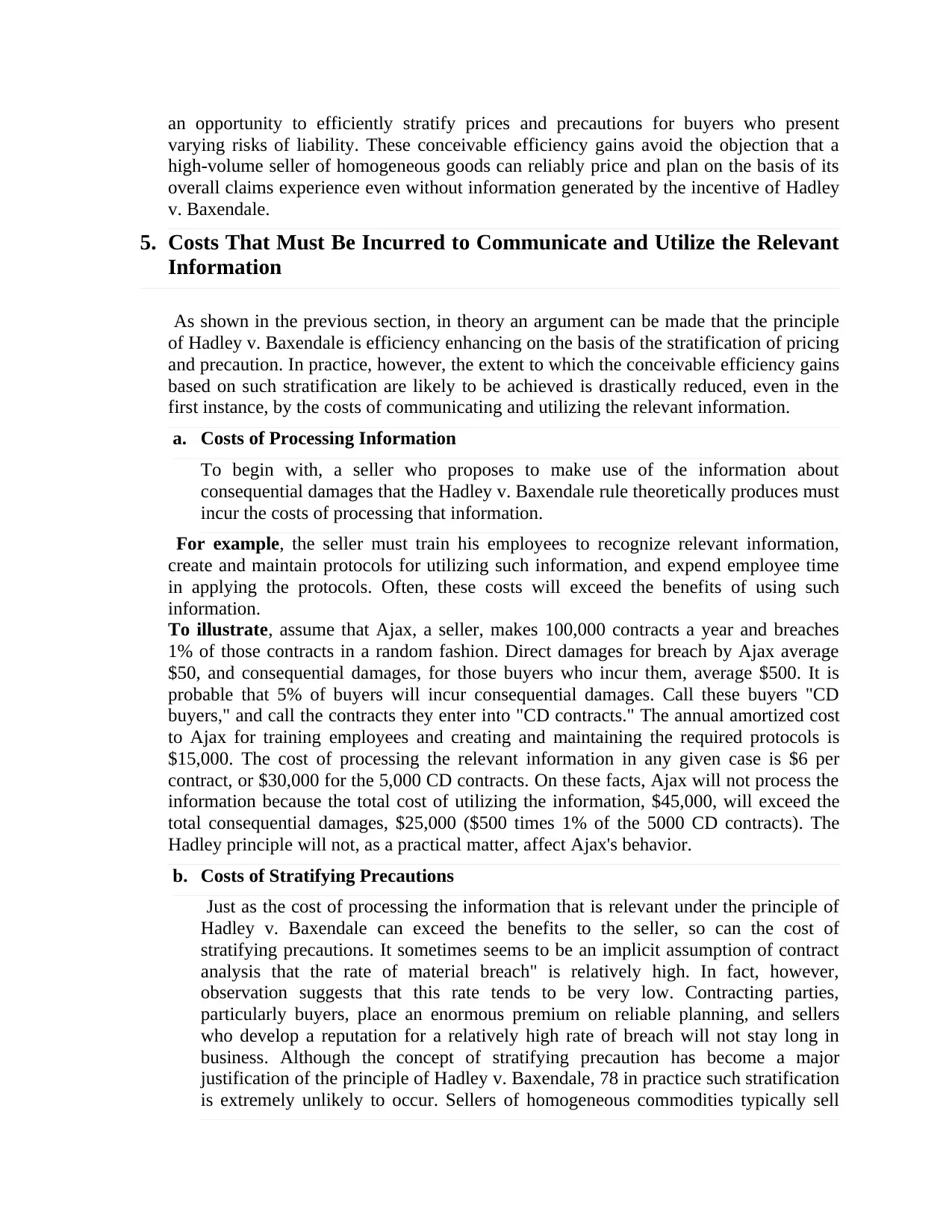
an opportunity to efficiently stratify prices and precautions for buyers who present
varying risks of liability. These conceivable efficiency gains avoid the objection that a
high-volume seller of homogeneous goods can reliably price and plan on the basis of its
overall claims experience even without information generated by the incentive of Hadley
v. Baxendale.
5. Costs That Must Be Incurred to Communicate and Utilize the Relevant
Information
As shown in the previous section, in theory an argument can be made that the principle
of Hadley v. Baxendale is efficiency enhancing on the basis of the stratification of pricing
and precaution. In practice, however, the extent to which the conceivable efficiency gains
based on such stratification are likely to be achieved is drastically reduced, even in the
first instance, by the costs of communicating and utilizing the relevant information.
a. Costs of Processing Information
To begin with, a seller who proposes to make use of the information about
consequential damages that the Hadley v. Baxendale rule theoretically produces must
incur the costs of processing that information.
For example, the seller must train his employees to recognize relevant information,
create and maintain protocols for utilizing such information, and expend employee time
in applying the protocols. Often, these costs will exceed the benefits of using such
information.
To illustrate, assume that Ajax, a seller, makes 100,000 contracts a year and breaches
1% of those contracts in a random fashion. Direct damages for breach by Ajax average
$50, and consequential damages, for those buyers who incur them, average $500. It is
probable that 5% of buyers will incur consequential damages. Call these buyers "CD
buyers," and call the contracts they enter into "CD contracts." The annual amortized cost
to Ajax for training employees and creating and maintaining the required protocols is
$15,000. The cost of processing the relevant information in any given case is $6 per
contract, or $30,000 for the 5,000 CD contracts. On these facts, Ajax will not process the
information because the total cost of utilizing the information, $45,000, will exceed the
total consequential damages, $25,000 ($500 times 1% of the 5000 CD contracts). The
Hadley principle will not, as a practical matter, affect Ajax's behavior.
b. Costs of Stratifying Precautions
Just as the cost of processing the information that is relevant under the principle of
Hadley v. Baxendale can exceed the benefits to the seller, so can the cost of
stratifying precautions. It sometimes seems to be an implicit assumption of contract
analysis that the rate of material breach" is relatively high. In fact, however,
observation suggests that this rate tends to be very low. Contracting parties,
particularly buyers, place an enormous premium on reliable planning, and sellers
who develop a reputation for a relatively high rate of breach will not stay long in
business. Although the concept of stratifying precaution has become a major
justification of the principle of Hadley v. Baxendale, 78 in practice such stratification
is extremely unlikely to occur. Sellers of homogeneous commodities typically sell
varying risks of liability. These conceivable efficiency gains avoid the objection that a
high-volume seller of homogeneous goods can reliably price and plan on the basis of its
overall claims experience even without information generated by the incentive of Hadley
v. Baxendale.
5. Costs That Must Be Incurred to Communicate and Utilize the Relevant
Information
As shown in the previous section, in theory an argument can be made that the principle
of Hadley v. Baxendale is efficiency enhancing on the basis of the stratification of pricing
and precaution. In practice, however, the extent to which the conceivable efficiency gains
based on such stratification are likely to be achieved is drastically reduced, even in the
first instance, by the costs of communicating and utilizing the relevant information.
a. Costs of Processing Information
To begin with, a seller who proposes to make use of the information about
consequential damages that the Hadley v. Baxendale rule theoretically produces must
incur the costs of processing that information.
For example, the seller must train his employees to recognize relevant information,
create and maintain protocols for utilizing such information, and expend employee time
in applying the protocols. Often, these costs will exceed the benefits of using such
information.
To illustrate, assume that Ajax, a seller, makes 100,000 contracts a year and breaches
1% of those contracts in a random fashion. Direct damages for breach by Ajax average
$50, and consequential damages, for those buyers who incur them, average $500. It is
probable that 5% of buyers will incur consequential damages. Call these buyers "CD
buyers," and call the contracts they enter into "CD contracts." The annual amortized cost
to Ajax for training employees and creating and maintaining the required protocols is
$15,000. The cost of processing the relevant information in any given case is $6 per
contract, or $30,000 for the 5,000 CD contracts. On these facts, Ajax will not process the
information because the total cost of utilizing the information, $45,000, will exceed the
total consequential damages, $25,000 ($500 times 1% of the 5000 CD contracts). The
Hadley principle will not, as a practical matter, affect Ajax's behavior.
b. Costs of Stratifying Precautions
Just as the cost of processing the information that is relevant under the principle of
Hadley v. Baxendale can exceed the benefits to the seller, so can the cost of
stratifying precautions. It sometimes seems to be an implicit assumption of contract
analysis that the rate of material breach" is relatively high. In fact, however,
observation suggests that this rate tends to be very low. Contracting parties,
particularly buyers, place an enormous premium on reliable planning, and sellers
who develop a reputation for a relatively high rate of breach will not stay long in
business. Although the concept of stratifying precaution has become a major
justification of the principle of Hadley v. Baxendale, 78 in practice such stratification
is extremely unlikely to occur. Sellers of homogeneous commodities typically sell
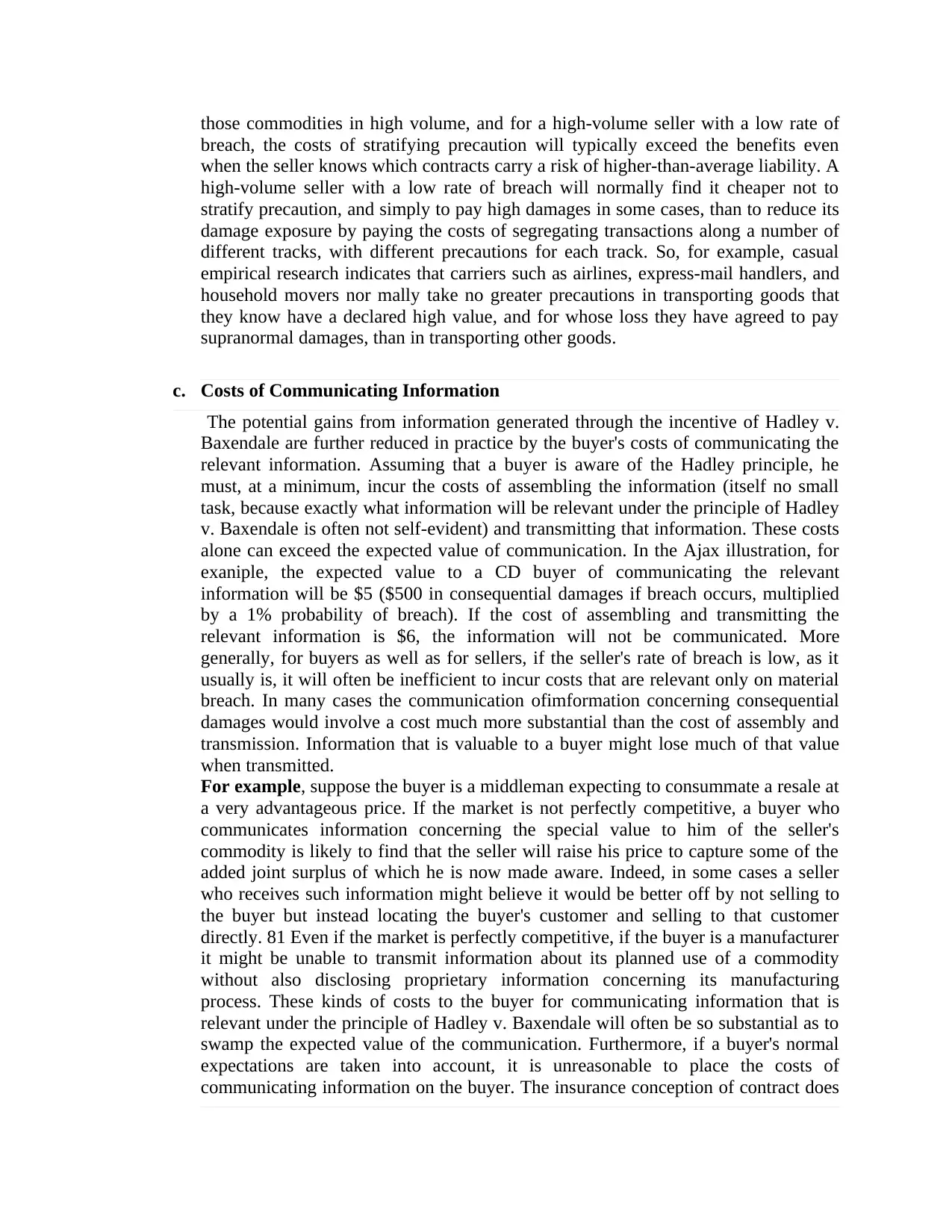
those commodities in high volume, and for a high-volume seller with a low rate of
breach, the costs of stratifying precaution will typically exceed the benefits even
when the seller knows which contracts carry a risk of higher-than-average liability. A
high-volume seller with a low rate of breach will normally find it cheaper not to
stratify precaution, and simply to pay high damages in some cases, than to reduce its
damage exposure by paying the costs of segregating transactions along a number of
different tracks, with different precautions for each track. So, for example, casual
empirical research indicates that carriers such as airlines, express-mail handlers, and
household movers nor mally take no greater precautions in transporting goods that
they know have a declared high value, and for whose loss they have agreed to pay
supranormal damages, than in transporting other goods.
c. Costs of Communicating Information
The potential gains from information generated through the incentive of Hadley v.
Baxendale are further reduced in practice by the buyer's costs of communicating the
relevant information. Assuming that a buyer is aware of the Hadley principle, he
must, at a minimum, incur the costs of assembling the information (itself no small
task, because exactly what information will be relevant under the principle of Hadley
v. Baxendale is often not self-evident) and transmitting that information. These costs
alone can exceed the expected value of communication. In the Ajax illustration, for
exaniple, the expected value to a CD buyer of communicating the relevant
information will be $5 ($500 in consequential damages if breach occurs, multiplied
by a 1% probability of breach). If the cost of assembling and transmitting the
relevant information is $6, the information will not be communicated. More
generally, for buyers as well as for sellers, if the seller's rate of breach is low, as it
usually is, it will often be inefficient to incur costs that are relevant only on material
breach. In many cases the communication ofimformation concerning consequential
damages would involve a cost much more substantial than the cost of assembly and
transmission. Information that is valuable to a buyer might lose much of that value
when transmitted.
For example, suppose the buyer is a middleman expecting to consummate a resale at
a very advantageous price. If the market is not perfectly competitive, a buyer who
communicates information concerning the special value to him of the seller's
commodity is likely to find that the seller will raise his price to capture some of the
added joint surplus of which he is now made aware. Indeed, in some cases a seller
who receives such information might believe it would be better off by not selling to
the buyer but instead locating the buyer's customer and selling to that customer
directly. 81 Even if the market is perfectly competitive, if the buyer is a manufacturer
it might be unable to transmit information about its planned use of a commodity
without also disclosing proprietary information concerning its manufacturing
process. These kinds of costs to the buyer for communicating information that is
relevant under the principle of Hadley v. Baxendale will often be so substantial as to
swamp the expected value of the communication. Furthermore, if a buyer's normal
expectations are taken into account, it is unreasonable to place the costs of
communicating information on the buyer. The insurance conception of contract does
breach, the costs of stratifying precaution will typically exceed the benefits even
when the seller knows which contracts carry a risk of higher-than-average liability. A
high-volume seller with a low rate of breach will normally find it cheaper not to
stratify precaution, and simply to pay high damages in some cases, than to reduce its
damage exposure by paying the costs of segregating transactions along a number of
different tracks, with different precautions for each track. So, for example, casual
empirical research indicates that carriers such as airlines, express-mail handlers, and
household movers nor mally take no greater precautions in transporting goods that
they know have a declared high value, and for whose loss they have agreed to pay
supranormal damages, than in transporting other goods.
c. Costs of Communicating Information
The potential gains from information generated through the incentive of Hadley v.
Baxendale are further reduced in practice by the buyer's costs of communicating the
relevant information. Assuming that a buyer is aware of the Hadley principle, he
must, at a minimum, incur the costs of assembling the information (itself no small
task, because exactly what information will be relevant under the principle of Hadley
v. Baxendale is often not self-evident) and transmitting that information. These costs
alone can exceed the expected value of communication. In the Ajax illustration, for
exaniple, the expected value to a CD buyer of communicating the relevant
information will be $5 ($500 in consequential damages if breach occurs, multiplied
by a 1% probability of breach). If the cost of assembling and transmitting the
relevant information is $6, the information will not be communicated. More
generally, for buyers as well as for sellers, if the seller's rate of breach is low, as it
usually is, it will often be inefficient to incur costs that are relevant only on material
breach. In many cases the communication ofimformation concerning consequential
damages would involve a cost much more substantial than the cost of assembly and
transmission. Information that is valuable to a buyer might lose much of that value
when transmitted.
For example, suppose the buyer is a middleman expecting to consummate a resale at
a very advantageous price. If the market is not perfectly competitive, a buyer who
communicates information concerning the special value to him of the seller's
commodity is likely to find that the seller will raise his price to capture some of the
added joint surplus of which he is now made aware. Indeed, in some cases a seller
who receives such information might believe it would be better off by not selling to
the buyer but instead locating the buyer's customer and selling to that customer
directly. 81 Even if the market is perfectly competitive, if the buyer is a manufacturer
it might be unable to transmit information about its planned use of a commodity
without also disclosing proprietary information concerning its manufacturing
process. These kinds of costs to the buyer for communicating information that is
relevant under the principle of Hadley v. Baxendale will often be so substantial as to
swamp the expected value of the communication. Furthermore, if a buyer's normal
expectations are taken into account, it is unreasonable to place the costs of
communicating information on the buyer. The insurance conception of contract does
⊘ This is a preview!⊘
Do you want full access?
Subscribe today to unlock all pages.

Trusted by 1+ million students worldwide
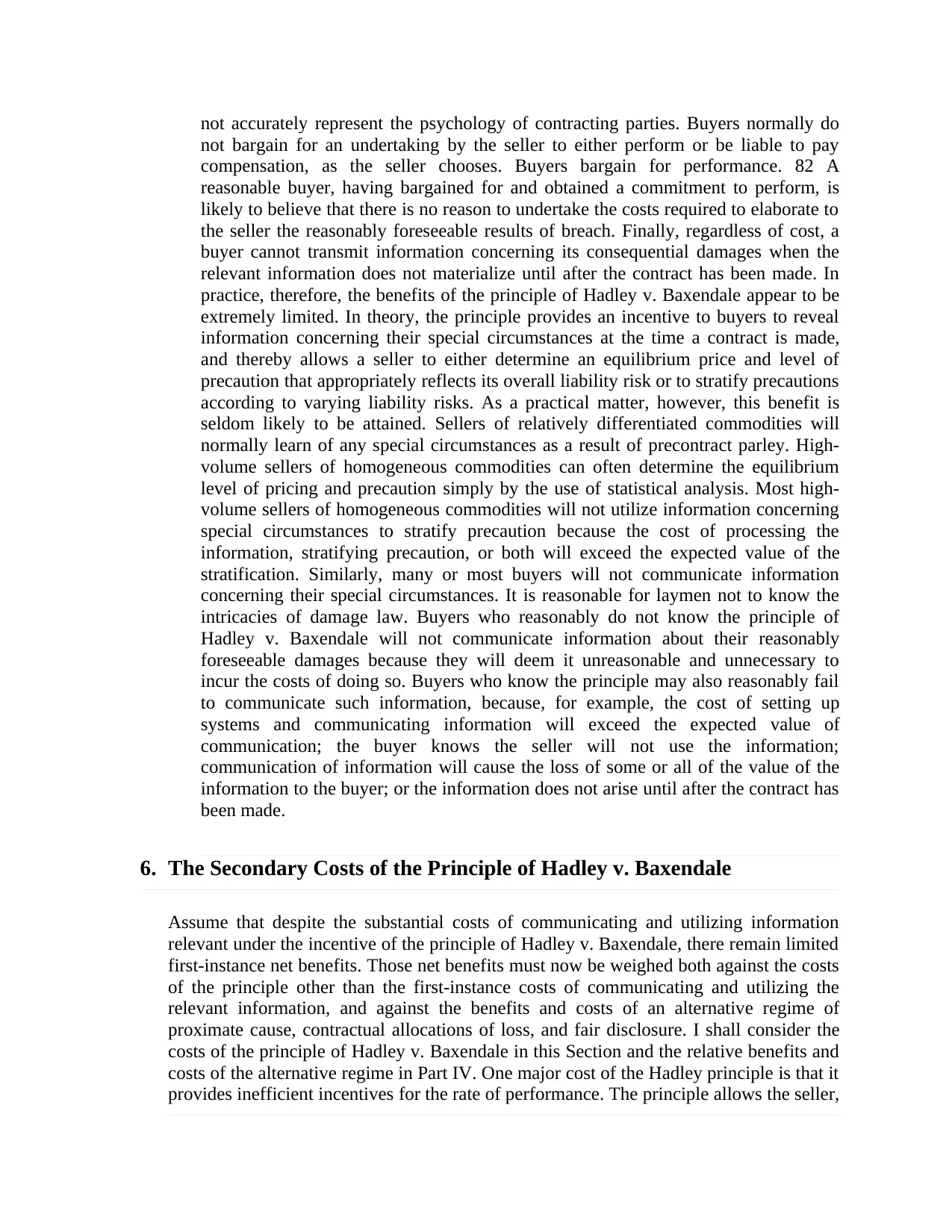
not accurately represent the psychology of contracting parties. Buyers normally do
not bargain for an undertaking by the seller to either perform or be liable to pay
compensation, as the seller chooses. Buyers bargain for performance. 82 A
reasonable buyer, having bargained for and obtained a commitment to perform, is
likely to believe that there is no reason to undertake the costs required to elaborate to
the seller the reasonably foreseeable results of breach. Finally, regardless of cost, a
buyer cannot transmit information concerning its consequential damages when the
relevant information does not materialize until after the contract has been made. In
practice, therefore, the benefits of the principle of Hadley v. Baxendale appear to be
extremely limited. In theory, the principle provides an incentive to buyers to reveal
information concerning their special circumstances at the time a contract is made,
and thereby allows a seller to either determine an equilibrium price and level of
precaution that appropriately reflects its overall liability risk or to stratify precautions
according to varying liability risks. As a practical matter, however, this benefit is
seldom likely to be attained. Sellers of relatively differentiated commodities will
normally learn of any special circumstances as a result of precontract parley. High-
volume sellers of homogeneous commodities can often determine the equilibrium
level of pricing and precaution simply by the use of statistical analysis. Most high-
volume sellers of homogeneous commodities will not utilize information concerning
special circumstances to stratify precaution because the cost of processing the
information, stratifying precaution, or both will exceed the expected value of the
stratification. Similarly, many or most buyers will not communicate information
concerning their special circumstances. It is reasonable for laymen not to know the
intricacies of damage law. Buyers who reasonably do not know the principle of
Hadley v. Baxendale will not communicate information about their reasonably
foreseeable damages because they will deem it unreasonable and unnecessary to
incur the costs of doing so. Buyers who know the principle may also reasonably fail
to communicate such information, because, for example, the cost of setting up
systems and communicating information will exceed the expected value of
communication; the buyer knows the seller will not use the information;
communication of information will cause the loss of some or all of the value of the
information to the buyer; or the information does not arise until after the contract has
been made.
6. The Secondary Costs of the Principle of Hadley v. Baxendale
Assume that despite the substantial costs of communicating and utilizing information
relevant under the incentive of the principle of Hadley v. Baxendale, there remain limited
first-instance net benefits. Those net benefits must now be weighed both against the costs
of the principle other than the first-instance costs of communicating and utilizing the
relevant information, and against the benefits and costs of an alternative regime of
proximate cause, contractual allocations of loss, and fair disclosure. I shall consider the
costs of the principle of Hadley v. Baxendale in this Section and the relative benefits and
costs of the alternative regime in Part IV. One major cost of the Hadley principle is that it
provides inefficient incentives for the rate of performance. The principle allows the seller,
not bargain for an undertaking by the seller to either perform or be liable to pay
compensation, as the seller chooses. Buyers bargain for performance. 82 A
reasonable buyer, having bargained for and obtained a commitment to perform, is
likely to believe that there is no reason to undertake the costs required to elaborate to
the seller the reasonably foreseeable results of breach. Finally, regardless of cost, a
buyer cannot transmit information concerning its consequential damages when the
relevant information does not materialize until after the contract has been made. In
practice, therefore, the benefits of the principle of Hadley v. Baxendale appear to be
extremely limited. In theory, the principle provides an incentive to buyers to reveal
information concerning their special circumstances at the time a contract is made,
and thereby allows a seller to either determine an equilibrium price and level of
precaution that appropriately reflects its overall liability risk or to stratify precautions
according to varying liability risks. As a practical matter, however, this benefit is
seldom likely to be attained. Sellers of relatively differentiated commodities will
normally learn of any special circumstances as a result of precontract parley. High-
volume sellers of homogeneous commodities can often determine the equilibrium
level of pricing and precaution simply by the use of statistical analysis. Most high-
volume sellers of homogeneous commodities will not utilize information concerning
special circumstances to stratify precaution because the cost of processing the
information, stratifying precaution, or both will exceed the expected value of the
stratification. Similarly, many or most buyers will not communicate information
concerning their special circumstances. It is reasonable for laymen not to know the
intricacies of damage law. Buyers who reasonably do not know the principle of
Hadley v. Baxendale will not communicate information about their reasonably
foreseeable damages because they will deem it unreasonable and unnecessary to
incur the costs of doing so. Buyers who know the principle may also reasonably fail
to communicate such information, because, for example, the cost of setting up
systems and communicating information will exceed the expected value of
communication; the buyer knows the seller will not use the information;
communication of information will cause the loss of some or all of the value of the
information to the buyer; or the information does not arise until after the contract has
been made.
6. The Secondary Costs of the Principle of Hadley v. Baxendale
Assume that despite the substantial costs of communicating and utilizing information
relevant under the incentive of the principle of Hadley v. Baxendale, there remain limited
first-instance net benefits. Those net benefits must now be weighed both against the costs
of the principle other than the first-instance costs of communicating and utilizing the
relevant information, and against the benefits and costs of an alternative regime of
proximate cause, contractual allocations of loss, and fair disclosure. I shall consider the
costs of the principle of Hadley v. Baxendale in this Section and the relative benefits and
costs of the alternative regime in Part IV. One major cost of the Hadley principle is that it
provides inefficient incentives for the rate of performance. The principle allows the seller,
Paraphrase This Document
Need a fresh take? Get an instant paraphrase of this document with our AI Paraphraser
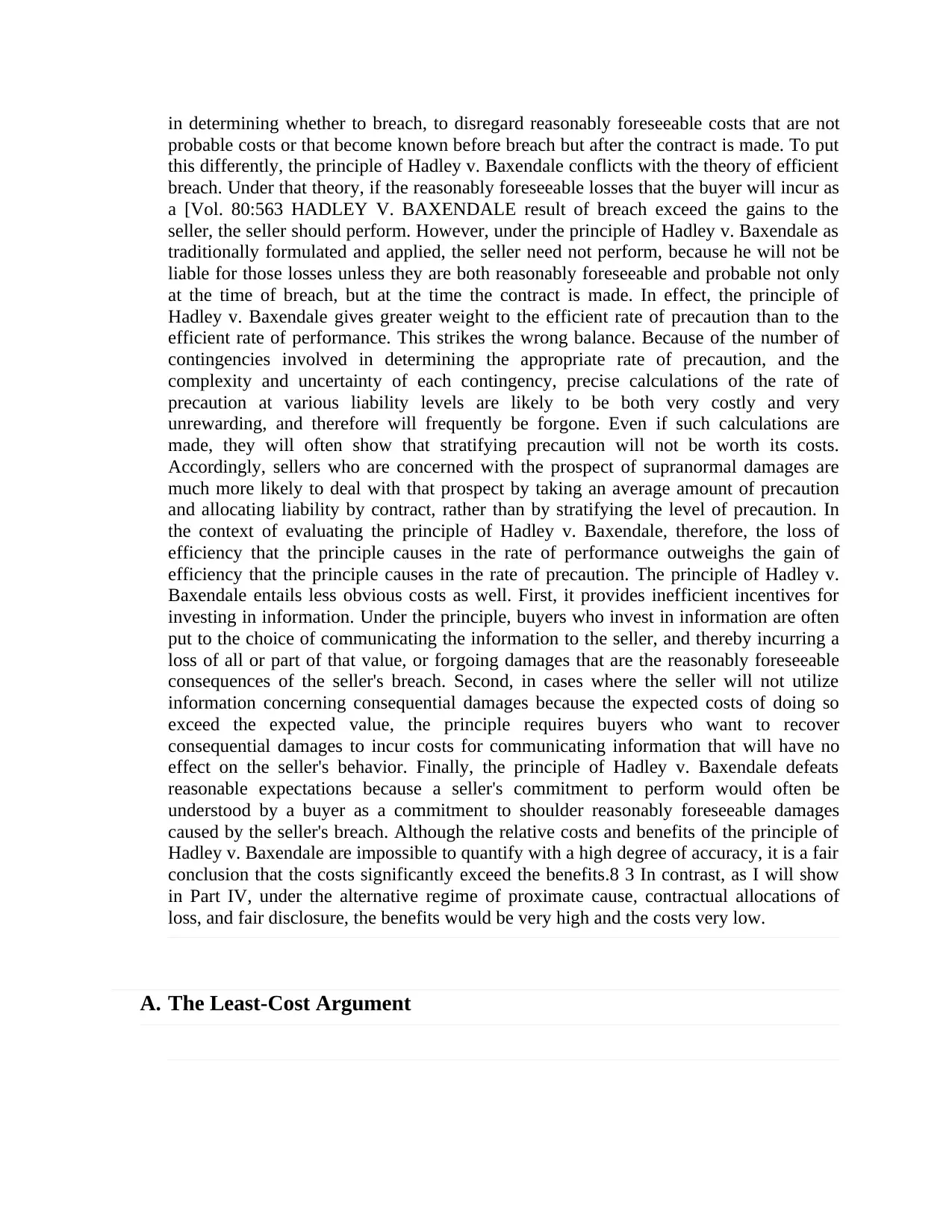
in determining whether to breach, to disregard reasonably foreseeable costs that are not
probable costs or that become known before breach but after the contract is made. To put
this differently, the principle of Hadley v. Baxendale conflicts with the theory of efficient
breach. Under that theory, if the reasonably foreseeable losses that the buyer will incur as
a [Vol. 80:563 HADLEY V. BAXENDALE result of breach exceed the gains to the
seller, the seller should perform. However, under the principle of Hadley v. Baxendale as
traditionally formulated and applied, the seller need not perform, because he will not be
liable for those losses unless they are both reasonably foreseeable and probable not only
at the time of breach, but at the time the contract is made. In effect, the principle of
Hadley v. Baxendale gives greater weight to the efficient rate of precaution than to the
efficient rate of performance. This strikes the wrong balance. Because of the number of
contingencies involved in determining the appropriate rate of precaution, and the
complexity and uncertainty of each contingency, precise calculations of the rate of
precaution at various liability levels are likely to be both very costly and very
unrewarding, and therefore will frequently be forgone. Even if such calculations are
made, they will often show that stratifying precaution will not be worth its costs.
Accordingly, sellers who are concerned with the prospect of supranormal damages are
much more likely to deal with that prospect by taking an average amount of precaution
and allocating liability by contract, rather than by stratifying the level of precaution. In
the context of evaluating the principle of Hadley v. Baxendale, therefore, the loss of
efficiency that the principle causes in the rate of performance outweighs the gain of
efficiency that the principle causes in the rate of precaution. The principle of Hadley v.
Baxendale entails less obvious costs as well. First, it provides inefficient incentives for
investing in information. Under the principle, buyers who invest in information are often
put to the choice of communicating the information to the seller, and thereby incurring a
loss of all or part of that value, or forgoing damages that are the reasonably foreseeable
consequences of the seller's breach. Second, in cases where the seller will not utilize
information concerning consequential damages because the expected costs of doing so
exceed the expected value, the principle requires buyers who want to recover
consequential damages to incur costs for communicating information that will have no
effect on the seller's behavior. Finally, the principle of Hadley v. Baxendale defeats
reasonable expectations because a seller's commitment to perform would often be
understood by a buyer as a commitment to shoulder reasonably foreseeable damages
caused by the seller's breach. Although the relative costs and benefits of the principle of
Hadley v. Baxendale are impossible to quantify with a high degree of accuracy, it is a fair
conclusion that the costs significantly exceed the benefits.8 3 In contrast, as I will show
in Part IV, under the alternative regime of proximate cause, contractual allocations of
loss, and fair disclosure, the benefits would be very high and the costs very low.
A. The Least-Cost Argument
probable costs or that become known before breach but after the contract is made. To put
this differently, the principle of Hadley v. Baxendale conflicts with the theory of efficient
breach. Under that theory, if the reasonably foreseeable losses that the buyer will incur as
a [Vol. 80:563 HADLEY V. BAXENDALE result of breach exceed the gains to the
seller, the seller should perform. However, under the principle of Hadley v. Baxendale as
traditionally formulated and applied, the seller need not perform, because he will not be
liable for those losses unless they are both reasonably foreseeable and probable not only
at the time of breach, but at the time the contract is made. In effect, the principle of
Hadley v. Baxendale gives greater weight to the efficient rate of precaution than to the
efficient rate of performance. This strikes the wrong balance. Because of the number of
contingencies involved in determining the appropriate rate of precaution, and the
complexity and uncertainty of each contingency, precise calculations of the rate of
precaution at various liability levels are likely to be both very costly and very
unrewarding, and therefore will frequently be forgone. Even if such calculations are
made, they will often show that stratifying precaution will not be worth its costs.
Accordingly, sellers who are concerned with the prospect of supranormal damages are
much more likely to deal with that prospect by taking an average amount of precaution
and allocating liability by contract, rather than by stratifying the level of precaution. In
the context of evaluating the principle of Hadley v. Baxendale, therefore, the loss of
efficiency that the principle causes in the rate of performance outweighs the gain of
efficiency that the principle causes in the rate of precaution. The principle of Hadley v.
Baxendale entails less obvious costs as well. First, it provides inefficient incentives for
investing in information. Under the principle, buyers who invest in information are often
put to the choice of communicating the information to the seller, and thereby incurring a
loss of all or part of that value, or forgoing damages that are the reasonably foreseeable
consequences of the seller's breach. Second, in cases where the seller will not utilize
information concerning consequential damages because the expected costs of doing so
exceed the expected value, the principle requires buyers who want to recover
consequential damages to incur costs for communicating information that will have no
effect on the seller's behavior. Finally, the principle of Hadley v. Baxendale defeats
reasonable expectations because a seller's commitment to perform would often be
understood by a buyer as a commitment to shoulder reasonably foreseeable damages
caused by the seller's breach. Although the relative costs and benefits of the principle of
Hadley v. Baxendale are impossible to quantify with a high degree of accuracy, it is a fair
conclusion that the costs significantly exceed the benefits.8 3 In contrast, as I will show
in Part IV, under the alternative regime of proximate cause, contractual allocations of
loss, and fair disclosure, the benefits would be very high and the costs very low.
A. The Least-Cost Argument
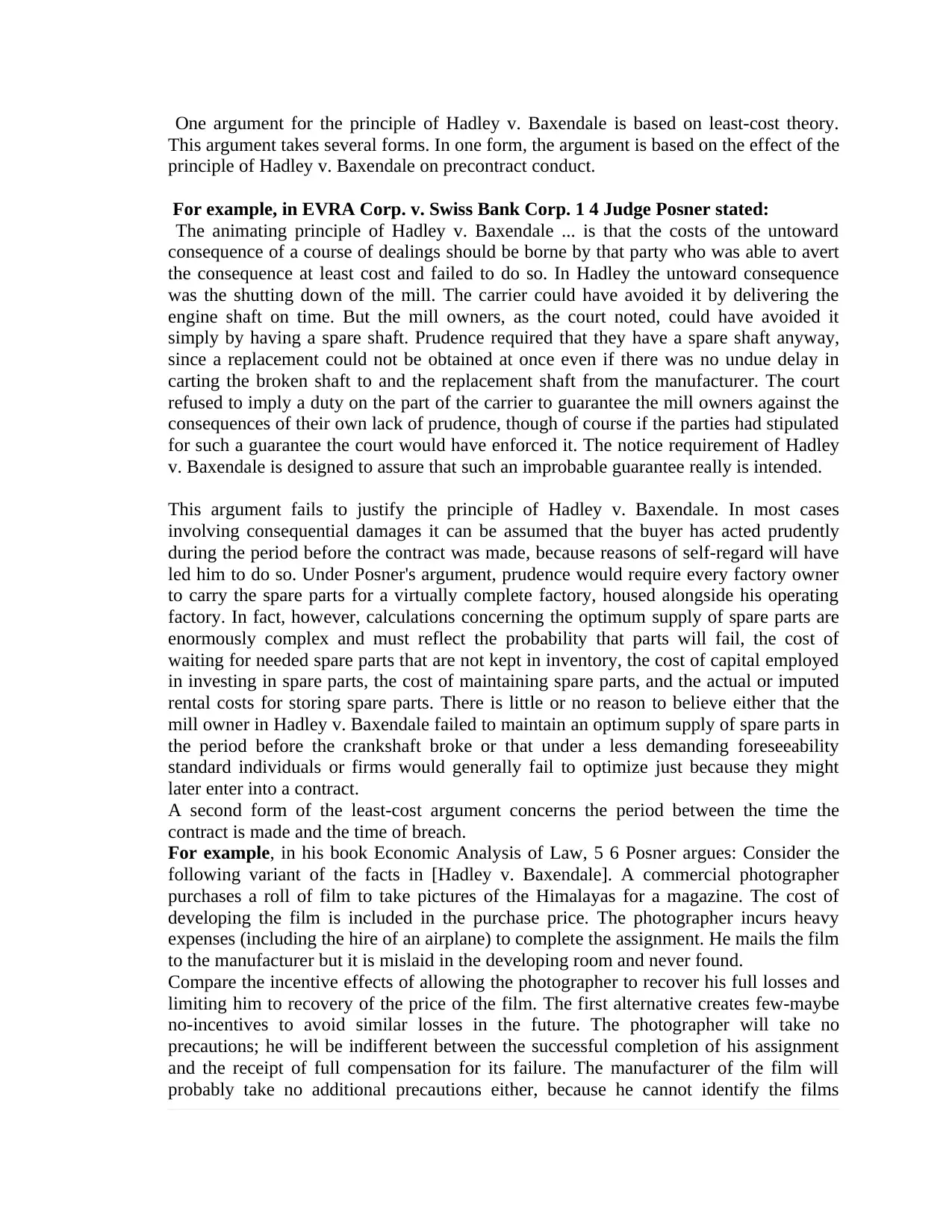
One argument for the principle of Hadley v. Baxendale is based on least-cost theory.
This argument takes several forms. In one form, the argument is based on the effect of the
principle of Hadley v. Baxendale on precontract conduct.
For example, in EVRA Corp. v. Swiss Bank Corp. 1 4 Judge Posner stated:
The animating principle of Hadley v. Baxendale ... is that the costs of the untoward
consequence of a course of dealings should be borne by that party who was able to avert
the consequence at least cost and failed to do so. In Hadley the untoward consequence
was the shutting down of the mill. The carrier could have avoided it by delivering the
engine shaft on time. But the mill owners, as the court noted, could have avoided it
simply by having a spare shaft. Prudence required that they have a spare shaft anyway,
since a replacement could not be obtained at once even if there was no undue delay in
carting the broken shaft to and the replacement shaft from the manufacturer. The court
refused to imply a duty on the part of the carrier to guarantee the mill owners against the
consequences of their own lack of prudence, though of course if the parties had stipulated
for such a guarantee the court would have enforced it. The notice requirement of Hadley
v. Baxendale is designed to assure that such an improbable guarantee really is intended.
This argument fails to justify the principle of Hadley v. Baxendale. In most cases
involving consequential damages it can be assumed that the buyer has acted prudently
during the period before the contract was made, because reasons of self-regard will have
led him to do so. Under Posner's argument, prudence would require every factory owner
to carry the spare parts for a virtually complete factory, housed alongside his operating
factory. In fact, however, calculations concerning the optimum supply of spare parts are
enormously complex and must reflect the probability that parts will fail, the cost of
waiting for needed spare parts that are not kept in inventory, the cost of capital employed
in investing in spare parts, the cost of maintaining spare parts, and the actual or imputed
rental costs for storing spare parts. There is little or no reason to believe either that the
mill owner in Hadley v. Baxendale failed to maintain an optimum supply of spare parts in
the period before the crankshaft broke or that under a less demanding foreseeability
standard individuals or firms would generally fail to optimize just because they might
later enter into a contract.
A second form of the least-cost argument concerns the period between the time the
contract is made and the time of breach.
For example, in his book Economic Analysis of Law, 5 6 Posner argues: Consider the
following variant of the facts in [Hadley v. Baxendale]. A commercial photographer
purchases a roll of film to take pictures of the Himalayas for a magazine. The cost of
developing the film is included in the purchase price. The photographer incurs heavy
expenses (including the hire of an airplane) to complete the assignment. He mails the film
to the manufacturer but it is mislaid in the developing room and never found.
Compare the incentive effects of allowing the photographer to recover his full losses and
limiting him to recovery of the price of the film. The first alternative creates few-maybe
no-incentives to avoid similar losses in the future. The photographer will take no
precautions; he will be indifferent between the successful completion of his assignment
and the receipt of full compensation for its failure. The manufacturer of the film will
probably take no additional precautions either, because he cannot identify the films
This argument takes several forms. In one form, the argument is based on the effect of the
principle of Hadley v. Baxendale on precontract conduct.
For example, in EVRA Corp. v. Swiss Bank Corp. 1 4 Judge Posner stated:
The animating principle of Hadley v. Baxendale ... is that the costs of the untoward
consequence of a course of dealings should be borne by that party who was able to avert
the consequence at least cost and failed to do so. In Hadley the untoward consequence
was the shutting down of the mill. The carrier could have avoided it by delivering the
engine shaft on time. But the mill owners, as the court noted, could have avoided it
simply by having a spare shaft. Prudence required that they have a spare shaft anyway,
since a replacement could not be obtained at once even if there was no undue delay in
carting the broken shaft to and the replacement shaft from the manufacturer. The court
refused to imply a duty on the part of the carrier to guarantee the mill owners against the
consequences of their own lack of prudence, though of course if the parties had stipulated
for such a guarantee the court would have enforced it. The notice requirement of Hadley
v. Baxendale is designed to assure that such an improbable guarantee really is intended.
This argument fails to justify the principle of Hadley v. Baxendale. In most cases
involving consequential damages it can be assumed that the buyer has acted prudently
during the period before the contract was made, because reasons of self-regard will have
led him to do so. Under Posner's argument, prudence would require every factory owner
to carry the spare parts for a virtually complete factory, housed alongside his operating
factory. In fact, however, calculations concerning the optimum supply of spare parts are
enormously complex and must reflect the probability that parts will fail, the cost of
waiting for needed spare parts that are not kept in inventory, the cost of capital employed
in investing in spare parts, the cost of maintaining spare parts, and the actual or imputed
rental costs for storing spare parts. There is little or no reason to believe either that the
mill owner in Hadley v. Baxendale failed to maintain an optimum supply of spare parts in
the period before the crankshaft broke or that under a less demanding foreseeability
standard individuals or firms would generally fail to optimize just because they might
later enter into a contract.
A second form of the least-cost argument concerns the period between the time the
contract is made and the time of breach.
For example, in his book Economic Analysis of Law, 5 6 Posner argues: Consider the
following variant of the facts in [Hadley v. Baxendale]. A commercial photographer
purchases a roll of film to take pictures of the Himalayas for a magazine. The cost of
developing the film is included in the purchase price. The photographer incurs heavy
expenses (including the hire of an airplane) to complete the assignment. He mails the film
to the manufacturer but it is mislaid in the developing room and never found.
Compare the incentive effects of allowing the photographer to recover his full losses and
limiting him to recovery of the price of the film. The first alternative creates few-maybe
no-incentives to avoid similar losses in the future. The photographer will take no
precautions; he will be indifferent between the successful completion of his assignment
and the receipt of full compensation for its failure. The manufacturer of the film will
probably take no additional precautions either, because he cannot identify the films
⊘ This is a preview!⊘
Do you want full access?
Subscribe today to unlock all pages.

Trusted by 1+ million students worldwide
1 out of 19
Related Documents
Your All-in-One AI-Powered Toolkit for Academic Success.
+13062052269
info@desklib.com
Available 24*7 on WhatsApp / Email
![[object Object]](/_next/static/media/star-bottom.7253800d.svg)
Unlock your academic potential
Copyright © 2020–2025 A2Z Services. All Rights Reserved. Developed and managed by ZUCOL.





